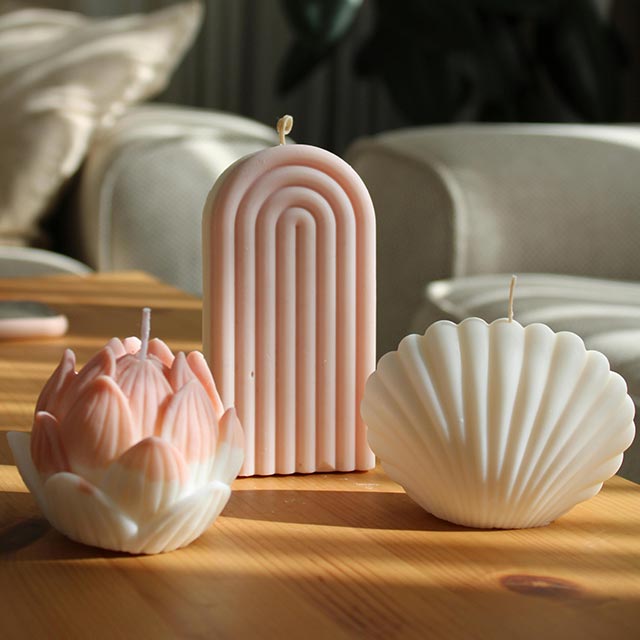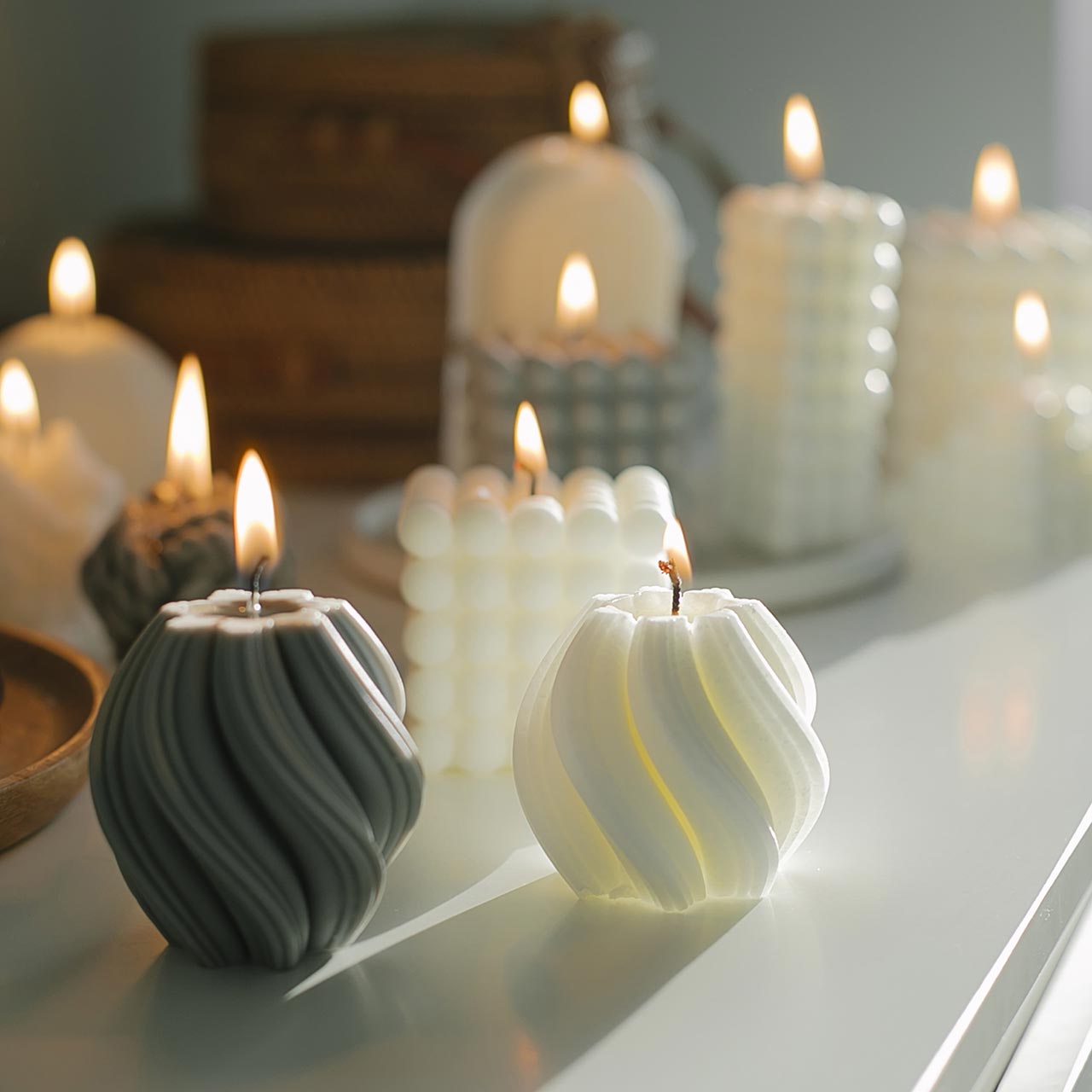How to Make Scented Candles with Candle Molds

Creating something with your own hands can be incredibly satisfying, especially when it adds warmth and ambiance to your home. If you've ever wondered how to make scented candles, you're in the right place. Whether you're a crafting enthusiast or considering starting a small candle-making business, making scented candles with molds is a delightful and rewarding endeavor.
This craft not only allows for creative expression but also lets you fill your space with custom fragrances that reflect your personal style. This comprehensive guide will walk you through the entire process, sharing valuable tips and insights along the way.
What Are Scented Candles?
Scented candles are more than just sources of light; they're mood-setters and atmosphere enhancers. By adding fragrance oils or essential oils to melted wax, it's possible to create candles that release delightful scents when burned. These aromas can evoke memories, enhance relaxation, or simply make a room feel more inviting.

Why Use Candle Molds for Scented Candles?
Using candle molds opens up a world of possibilities. Unlike traditional jar candles, molded candles can take on a variety of shapes and designs, making them perfect for gifts, home décor, or even starting your own product line.
Key Benefits of Using Candle Molds
- Customization: Candle molds allow for creating candles in countless shapes and sizes, from elegant pillars to whimsical designs.
- Professional Finish: Molded candles often have a smooth, polished appearance that looks professionally made.
- Versatility: Molds work with different types of wax, including soy, paraffin, and beeswax.
Embracing Sustainability in Candle Making
In the candle-making journey, choosing eco-friendly materials not only benefits the environment but also enhances the quality of the candles. Here are some ways to make the candle-making process more sustainable:
- Natural Waxes: Opt for soy or beeswax, which are renewable and biodegradable.
- Eco-Friendly Wicks: Use cotton or wooden wicks without metal cores.
- Non-Toxic Fragrances: Select phthalate-free fragrance oils or natural essential oils.
- Minimal Packaging: Reduce waste by using recyclable materials and avoiding excessive packaging.
Choosing the Right Wax
Selecting the right wax is a crucial step. Each type of wax has its own characteristics that affect the candle's burn time, scent throw, and appearance. For a deeper dive into the different options, check out our article: Types of Candle Wax: 8 Essential Varieties for Perfect Candles.

How Do I Make Scented Candles at Home?
Now, let's get into the heart of it. If you're wondering how to make scented candles at home, here's a step-by-step guide to help you create beautifully scented candles using molds.
Supplies You'll Need
Before starting, gather all the necessary materials. Having everything on hand makes the process smoother.
- Wax: Choose from soy, paraffin, or beeswax.
- Wicks: Select wicks suitable for your wax type and candle size.
- Fragrance Oil or Essential Oil: This is where you decide how much scent to add to candles. Typically, 6–10% of the total wax weight works well.
- Candle Molds: Silicone molds are user-friendly and come in various designs.
- Wick Holders: These keep the wick centered while the wax sets.
- Double Boiler or Melting Pot: For safely melting the wax.
- Thermometer: Keeping an eye on the temperature is key.
- Heat-Resistant Gloves and Safety Glasses: Safety first!
Step-by-Step Guide to Making Scented Candles

1. Prepare Your Workspace
Set up a clean, flat surface covered with newspaper or parchment paper to catch any spills. Ensure the area is well-ventilated. A little preparation here saves a lot of cleanup later.
2. Melt the Wax
Using a double boiler, gently melt the wax. Keep a close eye on the temperature with a thermometer. Each wax has an optimal melting point, so refer to the manufacturer's guidelines or use our Candle Wax Melting Temperature Guide for specifics.
3. Add the Fragrance
This is where the candle gets its aroma. Knowing how to add scent to candles is crucial:
- Temperature Matters: Let the wax cool slightly before adding the fragrance oil—usually to about 180°F (82°C) for soy wax.
- Measuring the Scent: Use a scale to measure the fragrance oil accurately. Our Candle Fragrance Load Calculator can help get it just right.
- Mix Thoroughly: Stir the mixture gently for a couple of minutes to ensure the scent is evenly distributed.
4. Prepare the Molds
Secure the wick in the center of the mold using a wick sticker or a bit of melted wax. Use a wick holder to keep it straight. A centered wick ensures an even burn.
5. Pour the Wax
Slowly pour the scented wax into the mold, being careful to avoid air bubbles. Leave a little space at the top of the mold.
6. Let It Cool
Patience is key here. Allow the candle to cool and set completely. This can take several hours. To estimate the cooling time, the Candle Wax Cooling Time Estimator is a handy tool.
7. Unmold the Candle
Once the candle is fully set, gently remove it from the mold. If it's a bit stubborn, placing it in the refrigerator for a short time can help.
8. Cure the Candle
Let the candle cure for the recommended time—usually 1–2 weeks for soy wax. This step enhances the scent throw when the candle is burned.
Choosing the Right Wick
Selecting the appropriate wick is essential for a clean, even burn. Factors to consider include:
- Candle Diameter: Wider candles need thicker wicks.
- Wax Type: Some waxes are denser and require a stronger wick.
- Fragrance Load: Heavily scented candles might need a larger wick.

Addressing Safety Concerns About Scented Candles
Common questions often arise, such as "Are scented candles toxic?" or "Can burning scented candles spark health issues?" The answers largely depend on the materials used.
Are Scented Candles Toxic?
Most commercially available candles are safe when used properly. However, some lower-quality candles might emit soot or harmful compounds. By making candles with natural waxes and high-quality fragrance oils, these risks are minimized.
Can Burning Scented Candles Spark Health Issues?
For most people, burning scented candles is harmless. Those with sensitivities or allergies should opt for candles scented with natural essential oils and ensure the room is well-ventilated.
Tips for Perfecting Your Scented Candles
- Temperature Control: Always monitor the wax temperature. It's crucial for scent binding and preventing imperfections.
- Accurate Measurements: Use tools like the Candle Fragrance Load Calculator to get fragrance ratios right.
- Avoiding Frosting: To minimize the white, chalky coating on soy candles, pour at lower temperatures and cool slowly.
- Record the Process: Keep notes on methods and results. It's invaluable for troubleshooting and replicating successes.
Safety Tips When Making Candles
- Stay Present: Never leave melting wax unattended.
- Protect Yourself: Wear gloves and safety glasses.
- Mind the Temperature: Avoid overheating wax or fragrance oils.
- Be Prepared: Keep a fire extinguisher or baking soda nearby.
Testing and Quality Assurance
Before sharing candles with others, it's important to perform a test burn:
- First Burn: Light the candle and let it burn until the melt pool reaches the edges.
- Observe: Look for a steady flame without flickering or smoking.
- Adjust if Needed: If issues are noticed, it might be necessary to tweak the wick size or fragrance load.
Common Problems and How to Fix Them

| Problem | Cause | Solution |
|---|---|---|
| Candle Tunneling | Wick too small | Use a larger wick or ensure full melt pools |
| Weak Scent Throw | Incorrect fragrance load or temperature | Adjust scent load; check pouring temperature |
| Cracked Surface | Cooling too quickly | Cool at room temperature; avoid drafts |
| Sinkholes | Wax shrinkage | Pour at lower temperature; refill holes if needed |
| Frosting | Natural soy wax characteristic | Pour at correct temperature; cool slowly |
| Wet Spots | Wax pulling from the mold | Preheat mold; adjust pouring temperature |
| Wick Mushrooming | Wick too large | Use a smaller wick; trim wick before burning |
| Sooting | Wick too large or drafts | Trim wick; eliminate drafts; use correct wick size |
Frequently Asked Questions (FAQ)
Q: How much scent should be added to candles?
A: Typically, 6–10% of the wax weight. For precision, use the Candle Fragrance Load Calculator.
Q: Why is the candle surface uneven?
A: This can happen if the candle cools too quickly. Try cooling it at room temperature and avoid moving it during the setting process.
Q: Are scented candles bad for you?
A: When made with natural waxes and high-quality fragrances, scented candles are generally safe. Always burn candles in well-ventilated areas.
Share Your Candle-Making Journey!
We'd love to hear about your experiences with candle making. Feel free to share your creations or ask any questions in the comments below. Let's build a community of candle enthusiasts who inspire and support each other.
Conclusion
Embarking on the journey of making scented candles is both fun and fulfilling. With the knowledge of how to make scented candles at home, and a bit of practice, it's possible to create beautiful pieces that add a personal touch to any space.
Remember to prioritize safety, embrace sustainability, and enjoy the creative process. Don't hesitate to experiment and find what works best.
For more resources, be sure to check out:
- Candle Wax Melting Temperature Guide
- Candle Wax Cooling Time Estimator
- Candle Fragrance Load Calculator
Happy candle making!


1 comment
Houston has so many creative opportunities, and candle-making workshops are such a great addition! Are there any that focus on eco-friendly techniques?
Sue
Leave a comment
This site is protected by hCaptcha and the hCaptcha Privacy Policy and Terms of Service apply.